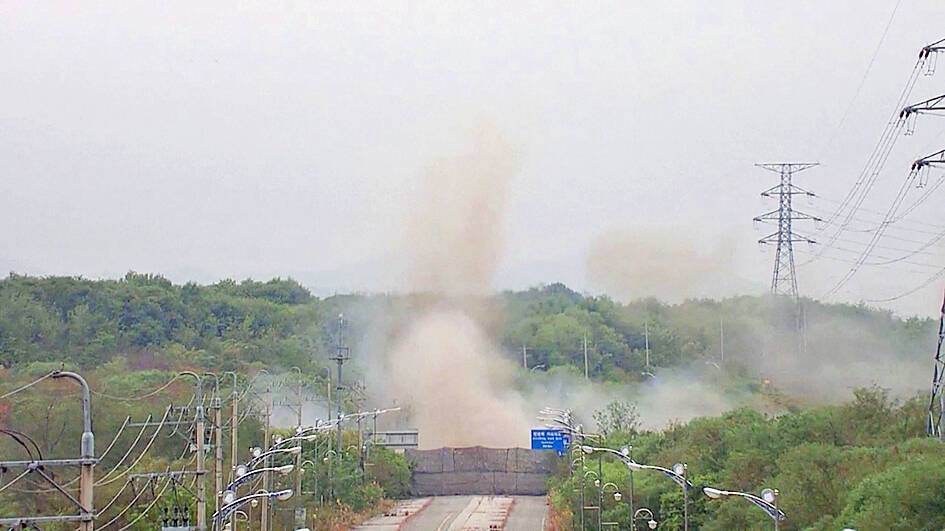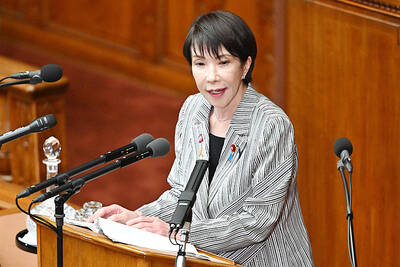North Korea is dismantling a facility at its Mount Kumgang resort used for hosting meetings between families separated after the Korean War, South Korea said yesterday, in the latest sign of strained tensions between the two Koreas.
The South Korean Ministry of Unification, which handles affairs between the nations, urged Pyongyang to immediately stop the action at the site near the border on the North’s east coast.
The 12-story building was built in 2008 with a budget of 55 billion won (US$37.86 million) funded by South Korea and includes an event hall and more than 200 guest rooms, the ministry said.

Photo: Reuters
The last tearful meeting between separated families was held at the venue in August 2018 before North Korea threatened to dismantle the resort the following year.
More than 130,000 South Koreans had registered to reunite with their separated families in the North as of December last year, with only 36,941 people still alive, government data showed.
The demolition of the facility is an “anti-humanitarian act that tramples on the wishes of separated families,” the ministry said, adding that it would consider legal measures over the action and a joint response with the international community.
The Mount Kumgang resort, located just beyond the demilitarized zone separating the two countries, was one of two major inter-Korean economic projects, along with the Kaesong industrial zone, seen as a symbol of rapprochement during decades of hostilities following the Korean War from 1950 to 1953.
North Korea blew up a joint liaison office in Kaesong in 2020 after complaining about defectors sending propaganda leaflets into the reclusive North.
North Korea has been escalating its rhetoric against its southern neighbour in recent years, designating South Korea as a “hostile state.”
Pyongyang also blew up sections of inter-Korean roads and rail lines on its side of the heavily fortified border last year, which prompted South Korea’s military to fire warning shots at the time.
Pyongyang in 2023 also scrapped a 2018 military accord designed to curb the risk of inadvertent clashes between two countries that remain technically at war, prompting the South to take a similar step.
Nonetheless, there have been signs that North Korea might be prepared to reopen to some foreign visitors for the first time in more than five years since the closure of its borders to tourism due to the COVID-19 pandemic.
Beijing-based Koryo Tours yesterday said tours to North Korea were “officially back,” with some of its staff allowed to enter the Rason area.

The Central Weather Administration (CWA) yesterday said it expected to issue a sea warning for Typhoon Fung-Wong tomorrow, which it said would possibly make landfall near central Taiwan. As of 2am yesterday, Fung-Wong was about 1,760km southeast of Oluanpi (鵝鑾鼻), Taiwan’s southernmost point, moving west-northwest at 26kph. It is forecast to reach Luzon in the northern Philippines by tomorrow, the CWA said. After entering the South China Sea, Typhoon Fung-Wong is likely to turn northward toward Taiwan, CWA forecaster Chang Chun-yao (張峻堯) said, adding that it would likely make landfall near central Taiwan. The CWA expects to issue a land

Taiwan’s exports soared to an all-time high of US$61.8 billion last month, surging 49.7 percent from a year earlier, as the global frenzy for artificial intelligence (AI) applications and new consumer electronics powered shipments of high-tech goods, the Ministry of Finance said yesterday. It was the first time exports had exceeded the US$60 billion mark, fueled by the global boom in AI development that has significantly boosted Taiwanese companies across the international supply chain, Department of Statistics Director-General Beatrice Tsai (蔡美娜) told a media briefing. “There is a consensus among major AI players that the upcycle is still in its early stage,”

The Central Weather Administration (CWA) yesterday said it is expected to issue a sea warning for Typhoon Fung-wong this afternoon and a land warning tomorrow. As of 1pm, the storm was about 1,070km southeast of Oluanpi (鵝鑾鼻), Taiwan’s southernmost point, and was moving west-northwest at 28 to 32kph, according to CWA data. The storm had a radius of 250km, with maximum sustained winds of 173kph and gusts reaching 209kph, the CWA added. The storm is forecast to pass near Luzon in the Philippines before entering the South China Sea and potentially turning northward toward Taiwan, the CWA said. CWA forecaster Chang Chun-yao (張峻堯) said

Japanese Prime Minister Sanae Takaichi yesterday said that China using armed force against Taiwan could constitute a "survival-threatening situation" for Japan, allowing the country to mobilize the Japanese armed forces under its security laws. Takaichi made the remarks during a parliamentary session while responding to a question about whether a "Taiwan contingency" involving a Chinese naval blockade would qualify as a "survival-threatening situation" for Japan, according to a report by Japan’s Asahi Shimbun. "If warships are used and other armed actions are involved, I believe this could constitute a survival-threatening situation," Takaichi was quoted as saying in the report. Under Japan’s security legislation,